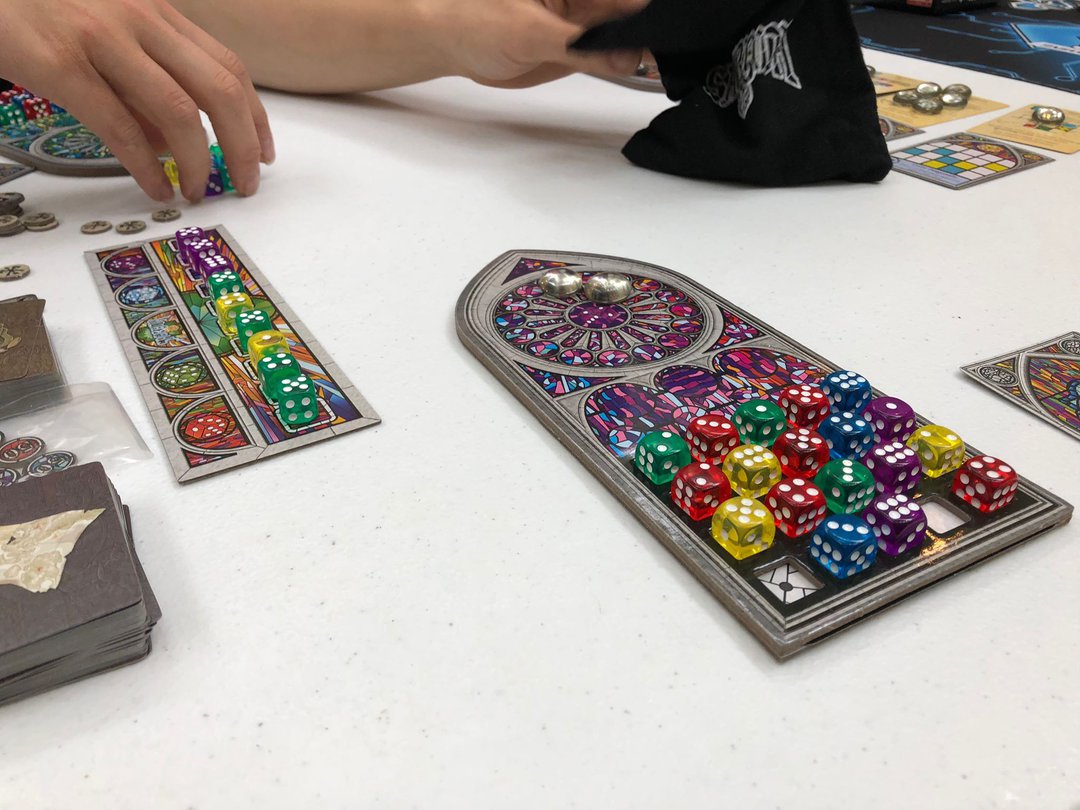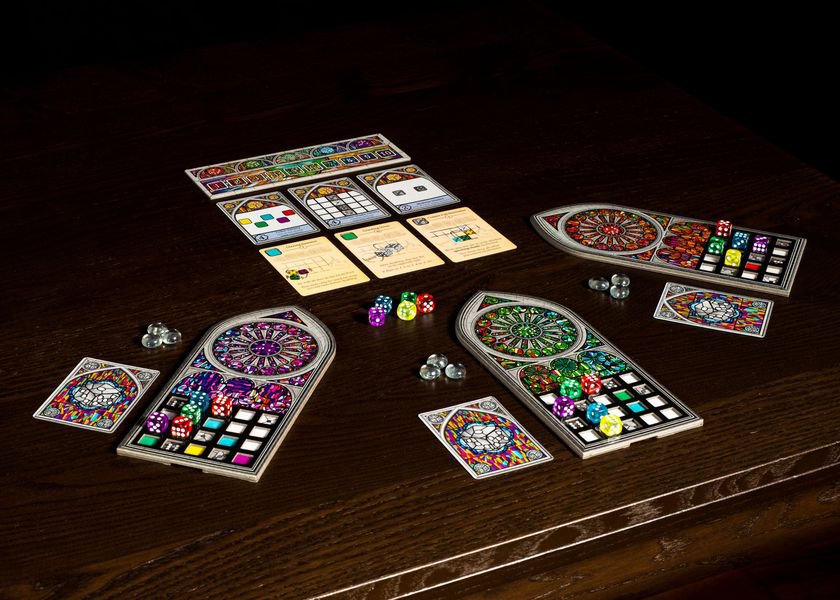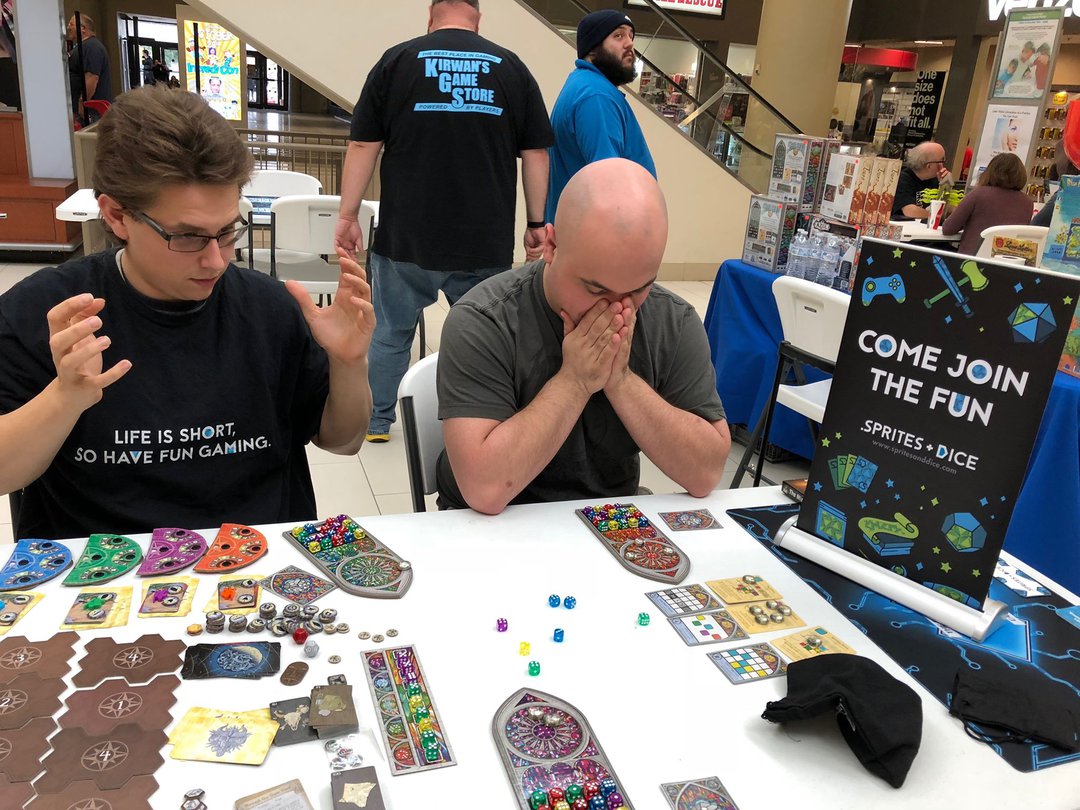Sagrada
Publisher: Floodgate Games
Format: Board Game
Number of Players: 1-4 Players
Play Time: Typically 45 Minutes
Price: $39.99
Copy Purchased By Reviewer
2017
While trying to write this review, I found myself asking a really weird question: why do so many board games like revolving around medieval and renaissance professions? Biblios, Viticulture, Agricola… Raiders of the North Sea… There are so many games that attempt to take what people did as a way of life and make it fun. As I transition over to writing a ton of board game content, I find myself amused that I’ve swapped from non-stop themes about saving the world or desperate survival that I usually see dominating the video game market. Now, I write about themes like making pretty glass windows, or crafting beautiful Spanish mosaics.
The transition is weird to me because in video games, the stakes always want to become higher. You play the original Diablo to try and save a town, and you end Diablo 3 by killing the Angel of Death. Halo went from being a super soldier to stopping galaxy wide invasions. That’s all fine by the way, but it perplexes me then about why I’m sitting here, talking about using very pretty dice to pantomime creating chapel windows.
It’s probably because these sort of board games are honestly a ton of fun.
What Is Sagrada, and How Does It Play?
The objective of the game and the theme go hand in hand here: You are an artisan working on the actual Sagrada Familia Cathedral in Spain. A stunning masterpiece of architectural achievement that has been touched by many hands (it has been under construction for over 136 years!}, you are a glassworker who wants to put their legacy into the cathedral. With that in mind, it’s time to make the best darn stained glass window you can.

If you are going to make a board game about an impressive building, the Sagrada Familia is probably one of your best picks!
Part of the beauty of Sagrada is how straight forward setup is, making it easy to get the basics of the game. Each player is dealt out two stained glass ‘frames’ that are double-sided. This gives you four options to choose from, and once one is chosen, you slot it into the cathedral pane you are given to keep it (and the dice you will use!) in place.
How do you choose a particular frame? The point of the game is earn as many points as possible over ten rounds; how you earn most points changes based on the secret objective you are given, and three objectives that everyone can see. The secret one is always based on a adding up the total sum of a particular dice color, and the public ones are typically things such as “have columns of dice that never repeats a color”, or “earn points based on sets of 1+2 numbered dice”. Each frame also comes with a set of dots at the bottom – this lets you know how hard the window pane might be to actually finish.

A half-finished game board. Look at how pretty it all is! This is an eye-catching game for sure.
Once everyone picks, round one begins. The first player rolls a set of dice, and chooses one to place in their panel. It’s simple and easy… at first. You drop each die you collect next to one you have already placed, so as you work towards the tenth round, it becomes harder and harder to find a fit to earn victory points. Did I mention you can’t place the same number (five next a five) or color (purple next to purple) adjacent to each other? Once you get to the tenth round, it's time to total up all your points, cheer about everything you did right, and freak out as you realize the mistakes you made.
Favor tokens and tools are one more modifier in all this fun. Favor tokens are worth points at the end of the game, but it's honestly better to use them to power the use of tools. While these tools are randomized each game, they can all be valuable. Maybe they allow you to swap dice you’ve already put into your glass pane; maybe they let you adjust a die to a different number. Either way, it’s a valuable asset that creates a little more interaction. Did you choose an easier window to complete? You may have 3-4 favor tokens, while players that are attempting harder ones might get 5-6; you have to balance how much you want to risk a tougher board to get more ways to manipulate your window.
What This Puzzle Game Does Right
What you get in Sagrada is an experience that feels magical, filled with possibility on round one. Of course, it also becomes an agonizing, hand-wringing puzzle by round ten. You can find yourself trying hard not to cheer loudly as you see multiple six-sided die in your window, which can give you a ton of points for your secret objective. You can ALSO find yourself cursing your hubris that same game, as you realize you forgot about a public objective. You can find yourself with a giant glaring hole in the middle of your stained glass window at the end of the game.
The roll of the dice every round can have you hold your breath, as your possible materials are plucked from the pouch. Some games might have you swearing as you see a round with no valuable reds, while others might give you too much too early, leaving you wanting by round ten. While you don’t directly interact with your opponents, I found myself cussing out my dear friends as they took the one die that I needed to complete a masterpiece row.

Sagrada is exciting, plain and simple. I’ve sometimes found myself more invested and more tense in this game of window-making than I have in a game about surviving an apocalypse. That’s a feat in itself.
The other main positive is the great attention to detail that Sagrada shows in all aspects. The art itself is neutral enough to not be distracting, but iconic enough to add to the theme. The dice – such a simple touch – glitter just enough to make you think they are glass. The panels you use as your game board have recessed slots to fill, so a bump of the table won’t destroy all your progress.
I also have to add that I love the turn order in this game: the first player each round is also the last player. As you choose dice from the pool, you go clockwise around the table until you hit the last player. At that point, the last player gets to pick a second die immediately, and it rotates back counter-clockwise. What this means is that every turn feels fair; each player either revels in the chance to pick first, or pick twice in a row.
As a final note that deserves to be mentioned: this is a great game to play solo! While I fully understand the love of competition, trying to make the very best window you can is a joy in and of itself. Each game is its own puzzle, and in each game, you always feel like it’s solvable. Playing solo has you competing against your own choices, and it turns Sagrada into a zen-like experience.
What Might Slow Your Glass Fitting
Sagrada has been out for over a year now, which means it's had a lot of time to pick up some opinions. The fact that we still feel the need to cover this game says a lot about its appeal and staying power, but it can sometimes be important to take a look at if a game has held up after the hype has gone down.
The good news is that Sagrada has held up, and is still a popular game to buy. Almost every reviewer appears to agree that this is a very well made game, with good game design, good production values, and a solid price point. With that being said, you can often find then one of the following follow ups: That Sagrada is either too simplistic, or too complicated. For those that enjoy deeper, longer puzzle games, Sagrada felt a little too light. While you can play competetively by trying to figure out other's secret objectives, picking dice to try and frustrate their moves, it doesn't have a lot of direct interaction. Most of the talking you'll be doing around the table is each player occasionally hissing and swearing at the inanimate dice on their boards, as the puzzles get harder. For the groups I've played with, it actually added a sense of camraderie.

This is often a look you will see during the game - realizing the dice have betrayed you.
On the opposite hand, some brand new players that like strictly story-based games had a little trouble with this one. Their first game felt fun, all the way up until the scoring; when they realized they hadn't kept track of one of the public objectives, or had mis-interpreted one, they felt a bit betrayed. Taking both sides into account, Sagrada might have a bit of a Goldilocks problem: for players that have established heavy game collections, they might feel this game is too random and too light. Players that enjoy lighter games might be drawn in, but then repelled by some of the abstraction that is part of the game. It's not so much a true complaint, but something to be aware of if you already have shelves full of games.
If there was one true complaint I could take up with the game, is that it's unplayable with a few people I know. Sagrada is a game that's wed to the concept of colors, and so if you have colorblind friends, this might not be the game for you.
Sagrada Is A Great Game To Start A Collection With
Sagrada captures the feeling of a roll and write game while augmenting it with some phenomenal components. It’s a very physical game: shaking the bag that has 90 dice in it, rolling your odds, choosing and placing your selection... it just feels more tangible than a lot of other games that have come in the same style.
I think Sagrada is an amazing game to get people into the hobby, or take the next step into more complicated board games. This is a game that has a lot of really fun concepts wrapped up in a theme that doesn’t scare people away. While there are absolutely more complex games in this style, they can often feel obtuse and hard for new players to understand. On the other side, there are smaller and simpler games as well, but most don’t have the same feeling of depth or sheer prettiness that the Sagrada box has.
I’m glad I have a copy on my shelf, because out of all I bring to game nights, this is one that’s been requested the most when they see it in our collection. For those of you out there who enjoy heavier games, don't worry: with expansions now out and more to come, I'm excited to see what's in store for the future.